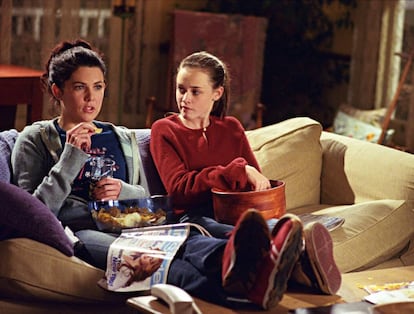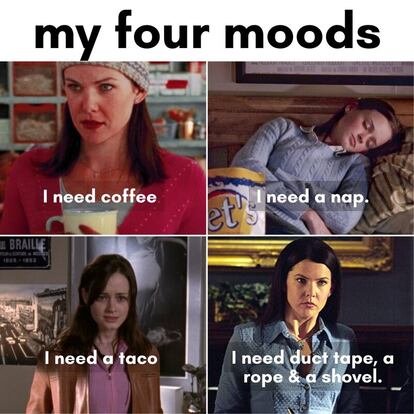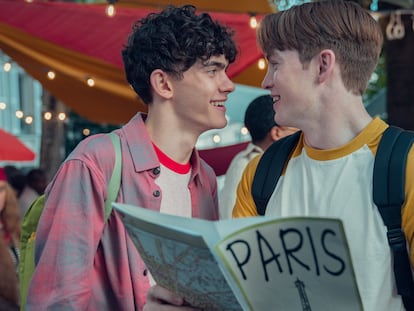Why ‘Gilmore Girls,’ the show that talked about feminism in the 2000s, makes us feel good in 2023
Fast-paced dialogue, pop culture and comfy sets made Lorelai and Rory cult figures. The show’s hashtag has 13 billion views on TikTok and more than a million views on Instagram

On October 5, 2000, the lives of Alexis Bledel and Lauren Graham changed forever. That day at 8 p.m., competing with Friends, the most-viewed show of the moment, Gilmore Girls was born. Since its debut 23 years ago, it has become a cult show with more and more fans each year, becoming a timeless phenomenon that transcends generations and streaming marathons. In the era of girl power, the series proved that women could shine on the small screen at a moment when conversations about feminism and equality were not on the table. A whirlwind of witty dialogue, sarcasm and cultural references, Gilmore Girls found its niche with millennials that began to awaken with the arrival of the 21st century.
But what’s the secret to the Gilmores’ continued relevance two decades later? Sociologist Marina López Baena, who specializes in feminism and is a fan of the show, analyzes it from a few perspectives. “On one hand, the portrait of the female characters with their biting dialogues full of cultural references and social satire; the representation, with its tensions and ambiguities, of the relationships between friends, mothers and daughters, grandmothers and granddaughters, and the space for characters played by women who are no longer young but still have desires and aspirations, such as Miss Patty or Emily Gilmore,” she states. “On the other hand, the settings and the characters. Through the repetition of faces and places, with unique secondary characters and Stars Hollow as another character, the show creates an atmosphere of familiarity, community and care, which has, in my opinion, a feminist reading, without idealizing life in towns.” She concludes, “it is also interesting to revisit it from a critical perspective that identifies the limitations of its hegemonic feminism.”
Sped-up dialogues and pop culture
One of the trademarks of the Sherman-Palladino house is its intense and rapid-fire script. Lauren Graham knew how to give her lines a personal touch from the beginning, turning the frenzy fueled by Lorelai’s coffee addiction — six a day, her character said in the pilot episode — into conversations that are sometimes difficult to follow on a screen. The series’ unofficial motto is “Life is short, talk fast.” At a time before WhatsApp and Instagram, Lorelai and Rory were already talking at 2x speed. Actor Scott Patterson, who played Luke, commented in an interview that he had to stop smoking to keep up with the dialogue. The show’s scripts had 80 pages for an hour of footage, compared to the usual 50.
The speed, without a doubt, has been and is one of its greatest attractions. The two protagonists are masters of the art of weaving pop culture into their everyday conversations, from Star Wars to Gray Gardens, Casablanca to Donna Reed, all sprinkled with pizza, tacos, Indian food, pancakes, and lots and lots of coffee — more than 500 cups between 2000 and 2007 — because food, of course, is another of the great protagonists of the show. (A Gilmore Girls cookbook was published in 2022.) All of these factors connect with the audience, bringing them into the Gilmores’ world, their inside jokes and their obsessions.
Literature is another of the great themes that marked the series. Rory said that she lived between two worlds, one of them that of books. In each chapter she reads an average of one or two, reaching a total of 387 books ranging from Proust to Jane Austen, which she reflects in her graduation speech: “One is a world of books. I’ve been a resident of Faulkner’s Yoknapatawpha County, hunted the white whale aboard the Pequod, fought alongside Napoleon, sailed a raft with Huck and Jim, committed absurdities with Ignatius J. Reilly, rode a sad train with Anna Karenina and strolled down Swann’s Way. It’s a rewarding world.” Marina López Baena believes that the representation of the pleasure of reading and the celebration of writing, especially by female authors, is still valid today. “The discussion between Rory, Jess, and Paris about classic authors and the Beat Generation is one that many of us could have had,” says the sociologist
Musically speaking, the series moves away from the mainstream of the early 2000s, introducing more independent groups that play an important role in both the plot and the ambience. The series’ theme song, Where You Lead, written by Carol King in 1971, is one of her most recognizable anthems. The singer recorded a new version especially for the series, a duet with her daughter. Among the most notable musical appearances throughout the seven seasons, Grant-Lee Phillips stands out as the official singer of Stars Hollow. The Bangles, Sonic Youth, The Shins and Yo la Tengo also appear. “There is a place specially reserved for feminist bands with women among their ranks such as The Distillers, The Banshees, B 52′s and the cameos of Kim Gordon and Carole King,” says Marina. “But I find it even more interesting how that aspect is introduced in most cases by Rory, Lorelai or Lane. We can’t forget the scene in which Lane has a date with a friend of Dean’s who appears with a Fugazi t-shirt that he had stolen ‘from his sister.’”
A generation of iconic women and diversity
From the unwavering loyalty and clumsiness of Sookie (Melissa McCarthy), to Rory’s lasting friendship with Lane (Keiko Agena) and Paris (Liza Weil), the series highlights the vitality of female friendships that are a source of strength and empowerment. Elements associated with women — makeup, face masks — are not a reason for ridicule, but for fun, although sometimes they fall into clichés typical of the time. Emily Gilmore, matriarch of the family, deserves special mention. Her character, marked by her social status, must survive new generations and a daughter who has never wanted to follow in the footsteps of the family inheritance. She is one of the figures, by the way, that evolves the most season after season.
The series also addresses social and economic issues with a fresh and realistic approach. Abandoning her parents’ comfortable life, Lorelai faces the reality of bills, making ends meet and raising a daughter. Beyond financial independence, the show takes on issues like the right to abortion, gender inequality and social pressure. For 25-year-old Adela, watching the series changed the direction of her life. “My favorite moment is when Rory calls her mother on the phone after months without speaking to tell her that she had decided to go back to school and that she had found a job. After that, she parks at the house and they hug. That moment impacted me a lot because I experienced a similar situation, and it helped me make the decision to return to school.”
Stars Hollow, a refuge on television
Long before the comfort TV that became popular during the pandemic, Gilmore Girls was already a refuge. Much of the blame lies with Stars Hollow, the fictional city where Lorelai and company live. The fictional Connecticut town of 10,000 inhabitants dresses up to welcome each season of the year. There, time doesn’t seem to pass. It is a microcosm that reflects the importance of community and local culture. From Luke’s café to Miss Patty’s dance school, each resident is a piece of the puzzle that brings the town to life.

Its cobblestone streets and picturesque facades are a call to nostalgia, a reminder that life can be beautiful in its simplicity. And at a time when screens are filled with special effects, Stars Hollow stands out for its authenticity, like a balm for any moment, ceasing to be a stage and becoming a state of mind. Africa, a 31-year-old fan, says that it is a series that is so comfortable that “you would like to live in all its episodes.” That is one of the keys: the familiarity of the place that makes you experience each of its routines as your own. It is the antithesis of the hustle and bustle, noise and stress of a big city, a space of solace where simplicity is celebrated as an art form.
Although the original series ended in 2007, on its tenth anniversary, Netflix, which took over the rights, recorded a four-episode special called Gilmore Girls: A Year in the Life, expanding its legacy and popularity thanks to streaming and allowing new generations to discover it. Social media has picked up the gauntlet and catapulted the series into the daily conversation of Generation Z. The show has a million followers on its official Instagram profile and 13.2 billion views on its TikTok hashtag, turning it into an unstoppable machine of smart, funny, feminist memes.
It is not surprising, then, that the Gilmores have become akin to a religion. Every October, thousands of people press play once again. In this universe, coffee is a metaphor for life: fast, hot and best shared with the women who inspire you.
Sign up for our weekly newsletter to get more English-language news coverage from EL PAÍS USA Edition
Tu suscripción se está usando en otro dispositivo
¿Quieres añadir otro usuario a tu suscripción?
Si continúas leyendo en este dispositivo, no se podrá leer en el otro.
FlechaTu suscripción se está usando en otro dispositivo y solo puedes acceder a EL PAÍS desde un dispositivo a la vez.
Si quieres compartir tu cuenta, cambia tu suscripción a la modalidad Premium, así podrás añadir otro usuario. Cada uno accederá con su propia cuenta de email, lo que os permitirá personalizar vuestra experiencia en EL PAÍS.
¿Tienes una suscripción de empresa? Accede aquí para contratar más cuentas.
En el caso de no saber quién está usando tu cuenta, te recomendamos cambiar tu contraseña aquí.
Si decides continuar compartiendo tu cuenta, este mensaje se mostrará en tu dispositivo y en el de la otra persona que está usando tu cuenta de forma indefinida, afectando a tu experiencia de lectura. Puedes consultar aquí los términos y condiciones de la suscripción digital.
More information
Archived In
Últimas noticias
There is as much life left to discover on planet Earth as that which is already known
Dozens presumed dead, around 100 injured in fire at Swiss Alps bar during New Year’s celebration
Is porn for women different from conventional porn? We spoke to those who make it
Cartagena de Indias is sinking: What can the city do to mitigate it?
Most viewed
- Sinaloa Cartel war is taking its toll on Los Chapitos
- Reinhard Genzel, Nobel laureate in physics: ‘One-minute videos will never give you the truth’
- David King, chemist: ‘There are scientists studying how to cool the planet; nobody should stop these experiments from happening’
- Oona Chaplin: ‘I told James Cameron that I was living in a treehouse and starting a permaculture project with a friend’
- The Interoceanic Train, the Mexican alternative to the Panama Canal









































